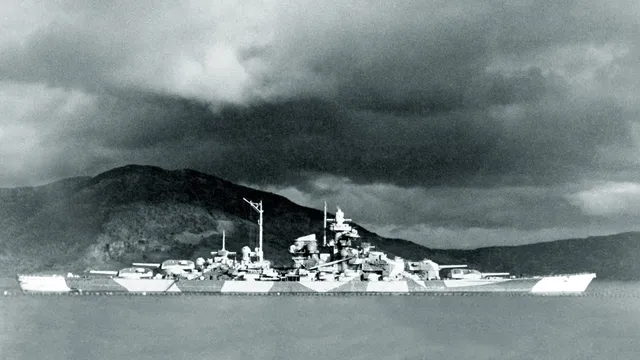
Tirpitz serves as a psychological weapon against Allied forces
2025-03-20 14:00- The Tirpitz was a Bismarck-class battleship launched by Germany to assert naval power against the British Royal Navy.
- It played a pivotal role by tying down significant Allied naval resources without engaging directly in many battles.
- Ultimately, the ship's existence invoked fear among the Allies, demonstrating its effectiveness as a psychological weapon of war.
Express your sentiment!
Insights
The German battleship Tirpitz, a marvel of engineering, was commissioned during World War II and became a formidable force in the European Theater. Displacing over 42,000 tons, the battleship was designed to challenge British naval supremacy, although it saw limited combat action. Its most significant contribution arose from its mere presence; stationed in Norway, it served as a 'fleet in being', tying down key Allied naval resources as they prepared for the possibility of engaging it. This strategic positioning created a psychological impact, resulting in the diversion of considerable naval assets by the British. In 1942, the threat posed by the Tirpitz was demonstrated when it influenced the fate of Convoy PQ-17. The British Admiralty, fearing an attack by the Tirpitz, ordered the convoy to disperse, rendering it vulnerable to German submarines and aircraft. This decision highlighted that the psychological warfare exerted by the Tirpitz had far-reaching implications, leading to severe losses for the Allies. Eventually, the British launched multiple operations to neutralize the Tirpitz, culminating in an attack by Lancaster bombers utilizing heavy 'Tallboy' bombs which successfully struck the battleship in 1944. Despite its limited direct engagements, the Tirpitz represented a symbolic and strategic challenge that focused significant Allied resources toward its containment. The battleship’s existence not only threatened British naval operations but also demoralized Allied forces who understood the ships could be deployed at any moment. Importantly, while the Tirpitz symbolized German naval power, the notion that it could effectively topple British dominance was overestimated. In assessing the Tirpitz's legacy, it becomes clear that its role was primarily one of deterrence rather than victory in conventional naval battles. The fear invoked by its potential deployment was a masterstroke of psychological warfare that underscored the importance of naval strategy in World War II. Ultimately, it embodied both the aspirations and limitations of the Kriegsmarine during the conflict, serving as a testament to the complex interplay of warfare, psychology, and strategy in a world at war.
Contexts
The Kriegsmarine, the naval forces of Nazi Germany during World War II, was critical in the execution of Germany's maritime strategies. Initially, the Kriegsmarine aimed to disrupt Allied shipping, safeguard Germany's own sea lines of communication, and project power in coastal and extended waters. Under the leadership of its commander, Grand Admiral Erich Raeder, the strategy focused on the construction of a fleet capable of engaging the Royal Navy, with an emphasis on U-boats (submarines), surface ships, and naval aviation. The principal aim was to establish control over the Atlantic Ocean and hinder the supply lines of the Allies, particularly between North America and Europe, yet the operational achievements often fell short of the ambitions espoused by the Nazi leadership. One of the most significant aspects of the Kriegsmarine strategy was its focus on unrestricted submarine warfare. U-boats were considered essential in the Battle of the Atlantic, which spanned much of the war. The strategy revolved around the targeting of merchant vessels, with the goal of crippling Britain's ability to sustain its war efforts. The early years of the war saw successes for U-boats, leading to considerable losses for the Allies. However, these victories were countered by advancements in anti-submarine warfare tactics by the Allies, including the development of sonar technology, depth charges, and the use of convoy systems, which ultimately diminished the effectiveness of U-boat operations. Surface engagements were another critical element of the Kriegsmarine's strategy, epitomized by the battleship Bismarck and the heavy cruiser Prinz Eugen’s sortie into the Atlantic in May 1941. These surface vessels aimed to disrupt Allied convoys, but operational constraints, including limitations in logistics and fuel, reduced their operational scope. The sinking of the Bismarck marked a turning point, revealing the vulnerabilities of even the most formidable warships when subjected to focused Allied efforts. As the war progressed, the Kriegsmarine struggled with resource allocation and the challenges of maintaining a larger maritime strategy combined with the growing pressure from Allied forces. As the tide of war turned against Germany, the Kriegsmarine's operational choices increasingly reflected desperation. The loss of experienced personnel and an inability to replace lost vessels diminished the fleet's effectiveness. Despite attempts to diversify its strategy with the development of fast attack craft, small submarines, and the construction of surface fleet capabilities, the Kriegsmarine could not adapt quickly enough to the rapidly changing dynamics of the conflict. By the war's end, the Kriegsmarine had failed to achieve its strategic objectives, leading to significant losses and contributing to Germany's ultimate defeat in 1945. In retrospective analyses, the Kriegsmarine's shortcomings illustrate the complexities of naval warfare and the perils of overambitious planning.